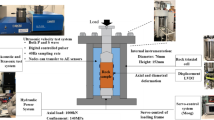Abstract
The fracture of ferroelectrics is a complex process which is influenced by various factors, among which are the domain switching near the crack tip, the crack face boundary conditions and the applied electric field. Domain switching near crack tips induces major local nonlinearity, while the crack face boundary conditions vary considerably due to different working conditions. In this work, a phase field model and a generalization of the configurational force theory into this model are used to investigate the microstructure around the crack tip and to quantitatively study the influence of the applied electric field and the crack face boundary conditions (permeable, impermeable, semi-permeable and energetically consistent). Evaluation of the fracture properties is done by the nodal configurational force at the crack tip based on the generalized configurational force theory. Results show that the induced domain structure relies significantly on the loading and on the surface boundary conditions. Among the four different conditions considered, the energetically consistent conditions lead to the smallest crack driving force, and the permeable conditions lead to the largest crack driving force. Calculations also show that positive electric fields tend to inhibit fracture, whereas negative electric fields tend to promote fracture.
Similar content being viewed by others
References
Chen YH, Hasebe N (2005) Current understanding on fracture behaviors of ferroelectric/piezoelectric materials. J Int Mate Syst Strut 16(7–8): 673–687
Deeg WF (1980) The analysis of dislocation, cracks, and inclusion problems in piezoelectric solids. Ph. D. Thesis, Stanford University, Stanford, California
Eshelby JD (1970) Energy relations and the energy-momentum tensor in continuum mechanics. In: Kanninen M.F. (eds) Inelastic behaviour of solids. McGraw Hill, New York, pp 77–115
Hao TH, Shen ZY (1994) A new electric boundary condition of electric fracture mechanics and its applications. Eng Fract Mech 47(6): 793–802
Jiang Y, Zhang Y, Liu B, Fang D (2009) Study on crack propagation in ferroelectric single cystal under electric loading. Acta Materialia 57: 1630–1638
Kamlah M (2001) Ferroelectric and ferroelastic piezoceramics—modeling of electromechanical hysteresis phenomena. Continuum Mech Thermodyn 13: 219–268
Landis CM (2004) Energetically consistent boundary conditions for electromechanical fracture. Int J Solids Struct 41: 6291–6315
Li W, Landis CM (2008) Phase-field modeling of domain switching near crack tips in single crystal ferroelectrics. In: Proceedings of the society of photo-optical instrumentation engineers (SPIE): behavior and mechanics of multifunctional and composite materials 6929: J9290–J9290. Conference information: conference on behavior and mechanics of multifunctional and composite materials, Date: MAR 10–13, 2008 San Diego CA Source: Behavior and mechanics of multifunctional and composite materials 2008, vol 6929, pp J9290–J9290 Published: 2008
Li W, McMeeking RM, Landis CM (2008) On the crack face boundary conditions in electromechanical fracture and an experimental protocol for determinining energy release rates. Eur J Mech A/Solids 27: 285–301
Maugin GA (1993) Material inhomogeneities in elasticity. Chapman & Hall, London
McMeeking RM (2004) The energy release rate for a Griffith crack in a piezoelectric material. Eng Frac Mech 71: 1169–1183
Mueller R, Maugin GA (2002) On material forces and finite element discretizations. Comput Mech 29(1): 52–60
Mueller R, Kolling S, Gross D (2002) On configurational forces in the context of the finite element method. Int J Numer Meth Eng 53: 1557–1574
Mueller R, Gross D, Schrade D, Xu BX (2007) Phase field simulation of domain structure in ferroelectric materials within the context of inhomogeneity evolution. Int J Frac 147(1–4): 173–180
Parton VZ (1976) Fracture mechanics of piezoelectric materials. Acta Atronautica 3: 671–683
Schneider GA (2007) Influence of electric field and mechanical stresses on the fracture of ferroelectrics. Ann Rev Mater Res 37: 491–538
Schrade D, Mueller R, Xu BX, Gross D (2007) Domain evolution in ferroelectric materials A continuum phase field model and finite element implementation. Comp Meth Appl Mech Eng 196: 4365–4374
Schrade D, Xu BX, Mueller R, Gross D (2009a) On phase field simulations of ferroelectrics: parameter identification and verification. In: Proceedings of the ASME 2008 smart materials, adaptive structures and intelligent systems (SMASIS2008), pp 301–308
Schrade D, Mueller R, Gross D (2009) Parameter identification in phase field models for ferroelectrics. Proc Appl Math Mech 9(1): 369–370
Song YC, Soh AK, Ni Y (2007) Phase field simulation of crack tip domain switching in ferroelectrics. J Phys D Appl Phys 40: 1175–1182
Wang H, Singh RN (1997) Crack propagation in piezoelectric ceramics effect of applied electric fields. J Appl Phys 81: 7471–7479
Wang J, Zhang TY (2007) Simulations of polarization switching-induced toughening in ferroelectric ceramics. Acta Mate 55: 2465–2477
Wippler K, Ricoeur A, Kuna M (2004) Towards the computation of electrically permeable cracks in piezoelectrics. Eng Fract Mech 71: 2567–2587
Xu BX, Schrade D, Mueller R, Gross D (2009) Micromechanical analysis of ferroelectric structures by a phase field method. Comput Mater Sci 45: 832–836
Yasuhide S, Fumio N, Fumitoshi S (2007) Electroelastic intersification and domain switching near a plane strain crack in a rectangular piezoelectric material. J Mech Mater Struct 2(8): 1525–1540
Zhang TY, Zhao M, Tong P (2002) Fracture of piezoelectric ceramics. Adv Appl Mech 38: 147–289
Zhang TY, Gao CF (2004) Fracture behaviors of piezoelectric materials. Theor Appl Frac Mech 41: 339–379
Author information
Authors and Affiliations
Corresponding author
Additional information
The generous support by the Alexander von Humboldt Foundation is gratefully acknowledged.
Rights and permissions
About this article
Cite this article
Xu, BX., Schrade, D., Gross, D. et al. Phase field simulation of domain structures in cracked ferroelectrics. Int J Fract 165, 163–173 (2010). https://doi.org/10.1007/s10704-010-9471-z
Received:
Accepted:
Published:
Issue Date:
DOI: https://doi.org/10.1007/s10704-010-9471-z




